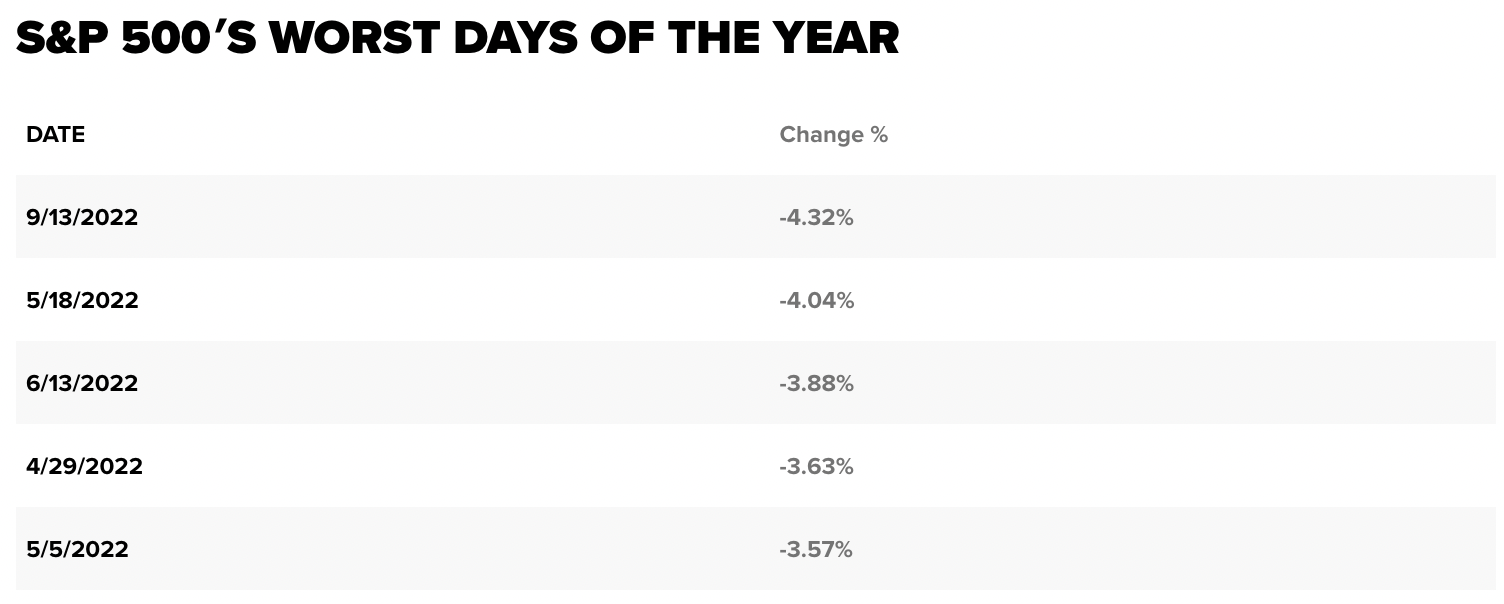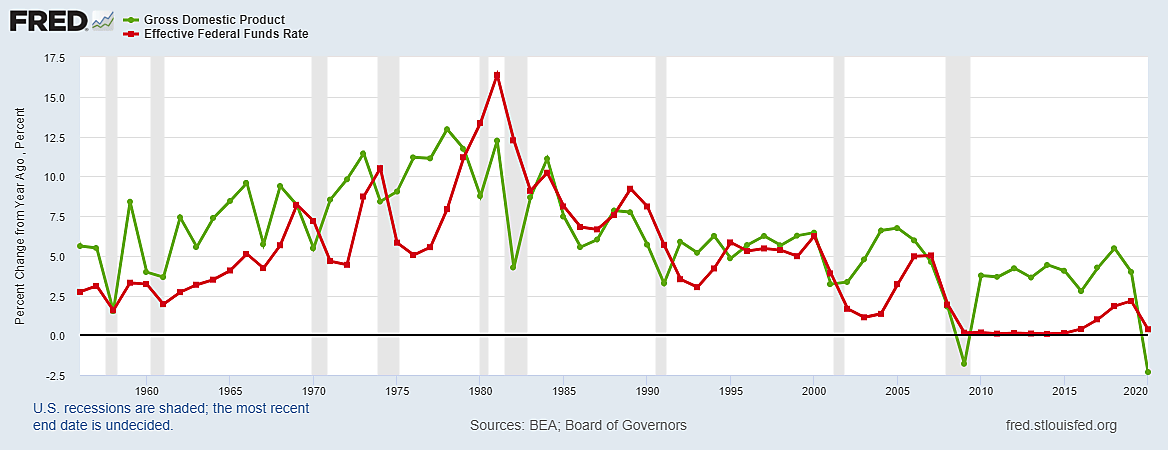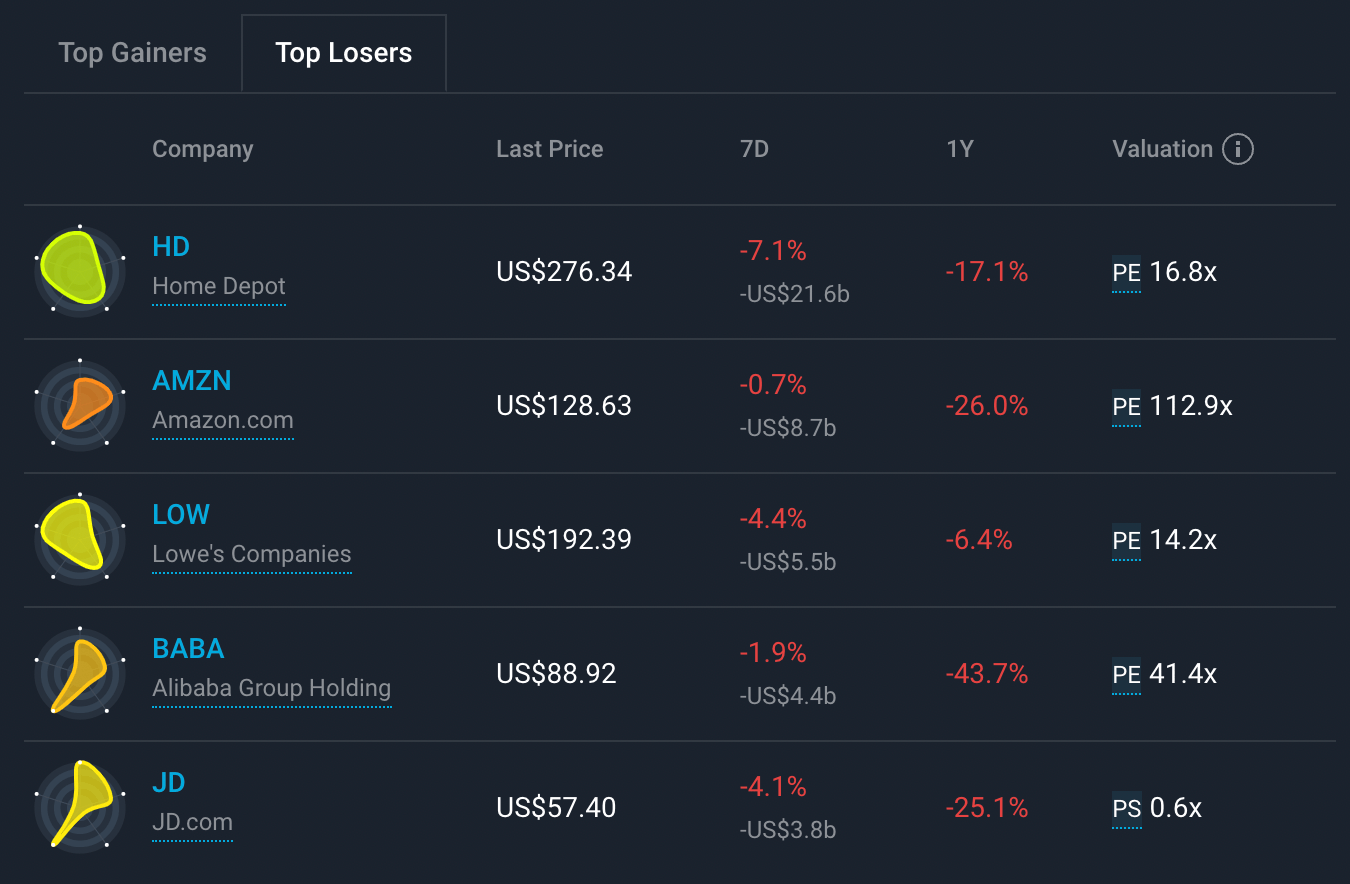What Happened in the Market This Week?
Market Insights for week ending 16th September
Equity markets in the U.S. continued in the red for the third consecutive week. Real estate and telecom suffered the biggest drops this week, while energy , consumer discretionary and healthcare outperformed the rest of the market.
This week also saw the release of various economic data, with the highly-discussed U.S. inflation data causing global market sentiment to sour quickly. Inflation data was also released for several European countries, including the U.K. , Germany , and Spain . The data showed extremely high numbers, aggregating into a 9.1% inflation rate in August (year-on-year) for the Euro area .
Additionally, the U.K. released GDP estimates for July, which showed a growth of 0.2% following a fall of 0.6% in June.

Some of the developments we have been watching over the week include:
- Global markets fell after U.S. inflation data came in higher than expected , giving investors a reality check.
- The U.K. may enter a recession sooner than anticipated , with economic growth slowing more than expected.
Global Markets’ Worst Day on U.S. CPI Surprise
Last Tuesday, equity markets experienced their worst day of 2022 after U.S. inflation data came in higher than expected. The Dow fell nearly 4%, while the S&P 500 index fell 4.3%.

Several notable companies even fell to new 52-week lows as risk appetite evaporated:
- Meta Platforms ( NASDAQ: META ) hit $150 - lowest since March 2020
- Intel Corporation ( NASDAQ: INTC ) hit $30 - lowest since Feb 2016
- Nvidia ( NASDAQ:NVDA ) hit $130 - lowest since March 2021
- Lumen Technologies ( NYSE:LUMN ) hit $8.95 - lowest since Nov 2020
- Sony Group ( NYSE:SONY ) hit $72 - lowest since July 2020
Why did the stock market drop?
U.S. CPI, commonly known as inflation, was 8.3% for this August (year-on-year) . This was slightly lower than July’s 8.5%, but higher than the 8.1% consensus forecast. Even more of a shock was the core CPI rate, which was 6.3% vs. forecasts of 5.9%. Core CPI excludes food and energy and reflects more persistent sources of inflation. A higher core CPI also means that it is no longer just energy costs rising, as rising energy costs had been a side effect of the Russian-Ukraine war .
The market had previously been hoping that the lower oil price would feed through to a lower inflation rate, and signal an easing in the pace of rate hikes. Despite Fed chairman Jerome Powell recently warning that higher rates are likely to persist for some time , the market was still hoping for some relief.
Why is inflation bad for the economy and stock market?
Generally, inflation is seen as a good thing as this means the economy is growing. Central banks usually target a 2-3% annual inflation rate, a healthy level signalling that consumer demand is high enough for businesses to grow and expand, but not too high that wages and businesses can’t catch up.
Inflation does reduce the purchasing power of money, which means consumer spending is more thinly spread around the economy. For an individual for example, a $100 bill would be able to buy less on higher inflation. It also translates to higher costs for businesses, thereby squeezing margins and leaving less for the bottom line - i.e. profits.
As such, inflation levels as they are now makes it difficult for businesses to plan, which results in lower business confidence, investment and hiring. For the overall economy, high inflation dampens profits, spending and investment.
Will the economy have a hard or soft landing?
The big question right now is the outlook the U.S. economy (and the global economy for that matter) is in for. A soft landing would see growth and rates normalize gradually. A hard landing would see a severe recession and possibly rising unemployment. Whichever way it goes, some investors are actually betting that a hard landing would result in interest rates falling sooner.
💡 The Insight: This isn’t a Normal Rate Cycle
During a normal cycle, strong GDP growth results in inflation and rate hikes as the economy grows. And then, rates are usually cut as soon as growth turns negative. It’s thus worth remembering that this isn’t a typical rate cycle. The chart below shows how rates usually follow GDP growth, and then fall during a recession (the shaded bands).

This time around, rates started rising when GDP growth was already contracting, and while the economy remains under pressure, rates continue to rise. The current situation has resulted from the unique combination of the Covid-19 pandemic and Russia-Ukraine war.
For Short or Medium-Term Investors (< 5 years)
Cyclical sectors like financials , consumer discretionary and industrials usually perform well when rates are rising. Cyclical industries are those that are relatively sensitive to business cycles - revenues are higher during expansionary periods and lower during contractionary periods. Generally however, this outperformance is usually the result of a growing economy, not just rising rates.
As such, while interest rates are indeed rising, defensive sectors ( utilities , healthcare and consumer staples ) may be less volatile and a better choice for some investors in the short term.
For Long-Term Investors (5+ years)
As a long-term investor, the underperformance of cyclical stocks may mean it's a good time to accumulate stocks at lower prices. Cyclical stocks have currently been hit hard due to the rising inflation and slowing economic activity. Remember though that these stocks will continue to follow market cycles in the future.

The U.K. May Enter a Recession Earlier than Expected
The U.K. is currently going through a tumultuous period, mainly due to the effects of the Russian-Ukraine war and now the passing of Queen Elizabeth II. In addition to a new Monarch, the U.K. has a new prime minister, Liz Truss, who now has to tackle the challenge of high inflation, a probable recession and an energy crisis.
Last week, it emerged that the U.K. economy grew by only 0.2% in July , underperforming compared to the 0.3% expected by economists. In June, the economy shrank by 0.6%, which was partly attributed to an extra bank holiday that lessened the month’s overall business activity.
With another bank holiday now declared for the Queen’s funeral, alongside the 10 days of mourning, analysts are now expecting that a technical recession ( two consecutive quarters of negative GDP growth , as explained in our previous Market Insight) would be coming about sooner than previously predicted.

UK Monthly GDP Composition - Image Credit: Bloomberg and Office for National Statistics
While growth during July was positive, construction and production was negative, and it was only the services sectors that held the average above zero.
What is GDP and what does it measure?
Economic growth is measured in terms of the annual change in GDP, or gross domestic product. GDP is calculated in various ways, but essentially amounts to the total value of goods and services that are sold in the economy. Lower GDP means less earning, spending and investment, and implies that on average everyone is a little poorer. As such, when GDP growth is negative for two consecutive quarters, a country enters what economists call, a technical recession.
GDP estimates for a given period are often amended a few times. The reason for this is that GDP really is just an estimate based on lots of different types of data. As new data becomes available, the original estimate gets updated - so it’s still an estimate, just a slightly more accurate one.
Energy price caps by U.K. PM Liz Truss
The U.K.’s inflation rate actually fell (and more than expected) in August , but at 9.9% it’s still very high. The primary driver of inflation is of course energy, as we had discussed last week . U.K. PM Liz Truss wants to tackle the energy crisis by capping energy bills for British consumers for two years. This moves the burden from the current consumer to the future taxpayer - consumers will still be paying the bill, just at a later stage when the U.K.'s central bank wants to lessen the debt it incurred from subsidizing energy prices.
You can read more about the ‘energy price guarantee’ here , but essentially it will save households around £1,000 a year. It’s hoped that this money will flow to other parts of the economy and limit the depth of the expected recession. But as said, it will also add to the country’s debt burden while borrowing costs are rising.
💡 The Insight: Effects of Holidays on the Economy
Bank holidays are regarded as a cost to the economy, though they affect the various sectors differently . Some sectors are less productive when employees work fewer days. But other sectors like tourism , hospitality and retail may benefit from increased consumer spending.
This is a good reminder that as the U.K. faces these economic challenges, not all sectors will be affected in the same way. Investors need to think about the effects of inflation and a slowing economy on different sectors.
For Short or Medium-Term Investors (< 5 years)
The U.K. faces many of the same challenges that we previously mentioned Europe is facing . Companies focused on the local U.K. economy are most vulnerable. These tend to be the small and mid-cap companies in the FTSE 250 and other indexes that include smaller companies. Many of the U.K.’s larger companies operate globally, so their performance won’t be affected as much by the local economy.
Short to Medium-term investors may find that investing in global corporations may be more defensive than choosing smaller, riskier companies.
For Long-Term Investors (5+ years)
All economies experience challenging periods from time to time, but the economies of developed nations such as the U.K. almost always recover based on history. If you have a longer time horizon, you may want to look for companies that are under pressure right now, but would thrive when the economy recovers.
It’s a good idea to spread your purchases out over time (dollar cost averaging) - trying to pick the bottom is close to impossible. Additionally, you reduce your portfolio's volatility by spreading your investments over time.
Key Events This Week
The key event this week that investors are highly anticipating will be the announcement of the Fed Funds rate on Wednesday . The market is expecting another 0.75% hike which will take the rate to 3.25%, the highest it's been since 2008. A higher rate signals a more contractionary stance taken by the central bank in a bid to fight inflation.
Away from the Fed's interest rate decision, inflation data are also due for Japan and Canada this week . Japan is currently still on a negative interest rate (as we explained last week!), so its inflation results will show whether they would be moving away from that in the near future. Meanwhile, Canada has also been battling high inflation in the last few months, and currently has a cash rate of 3.25%. If inflation stays persistently high in the country, they may have to raise rates once again.
Outside of rates, U.S. housing data for housing starts (the number of new residential construction) and the number of existing home sales will also be published on Tuesday and Wednesday respectively .
The U.K. interest rate decision was also supposed to be due on Thursday, but the Bank of England’s (BOE) meeting has been postponed until next week due to Queen Elizabeth’s passing.
Until next week,
Invest Well,
Simply Wall St
Have feedback on this article? Concerned about the content? Get in touch with us directly. Alternatively, email editorial-team@simplywallst.com
Simply Wall St analyst Richard Bowman and Simply Wall St have no position in any of the companies mentioned. This article is general in nature. We provide commentary based on historical data and analyst forecasts only using an unbiased methodology and our articles are not intended to be financial advice. It does not constitute a recommendation to buy or sell any stock and does not take account of your objectives, or your financial situation. We aim to bring you long-term focused analysis driven by fundamental data. Note that our analysis may not factor in the latest price-sensitive company announcements or qualitative material.

Richard Bowman
Richard is an analyst, writer and investor based in Cape Town, South Africa. He has written for several online investment publications and continues to do so. Richard is fascinated by economics, financial markets and behavioral finance. He is also passionate about tools and content that make investing accessible to everyone.
